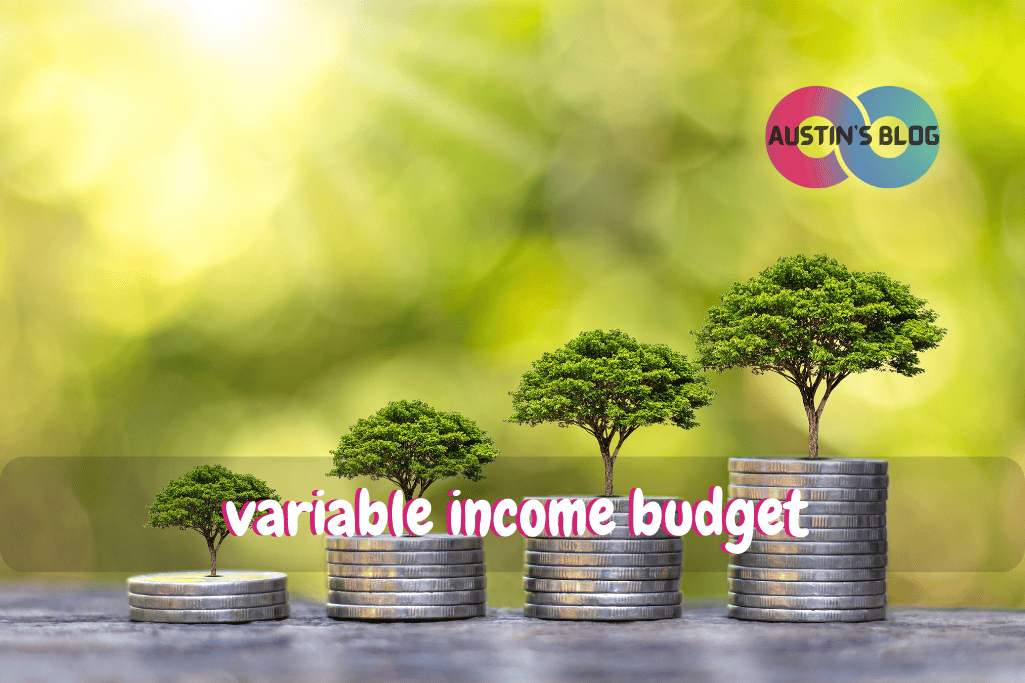The Complete Guide to Creating a Variable Income Budget for Freelancers
Introduction
Did you know that freelancers report financial anxiety due to income inconsistency, late payments, and unstable clients? [1]
I totally get it!
When I first started freelancing as a writer, I’d swing from flush months to penny-pinching panic, wondering how something as basic as budgeting could feel so impossible.
After years of trial and error, I’ve finally cracked the code on managing variable income.
In this comprehensive guide, I’ll share practical strategies for creating a variable income budget that actually works when your income fluctuates.
We’ll cover everything from building your financial foundation to implementing specific budgeting techniques designed for irregular income.
Understanding the Variable Income Challenge
Before diving into specific budgeting methods, it’s important to understand why traditional budgeting approaches often fail for those with inconsistent income.
Why Traditional Budgeting Fails Freelancers
Traditional budgeting assumes a predictable, steady paycheck arriving at regular intervals.
You know exactly how much is coming in and when, so you can plan your expenses accordingly. But freelance life couldn’t be more different!
I remember my first year freelancing when I earned $6,500 in March and barely $1,200 in April.
Talk about financial whiplash! With this kind of fluctuation, traditional budget methods that allocate specific dollar amounts to categories each month simply don’t work.
Beyond the obvious income variability, freelancers also face unique challenges like:
- Irregular payment timing (clients paying late)
- Seasonal business fluctuations
- Project-based income rather than hourly
- Self-funded benefits and taxes
These factors create a perfect storm that makes conventional budgeting advice nearly useless for those with variable income.
The Psychological Impact of Income Uncertainty
Let’s talk about something many financial experts overlook – the emotional toll of income uncertainty.
The constant worry about whether you’ll make enough next month can be exhausting.
During my early freelancing days, I found myself trapped in a feast-or-famine mentality.
During high-income months, I’d feel flush and spend freely. Then during inevitable slow periods, I’d stress about basic expenses.
This emotional rollercoaster affected not just my finances but my creativity and work quality too.
Creating a variable income budget isn’t just about the numbers – it’s about building financial confidence and reducing the anxiety that comes with income uncertainty.
Building Your Financial Foundation
Before implementing specific budgeting techniques, you need to establish some fundamental financial elements.
Calculate Your Baseline Monthly Needs
The cornerstone of any variable income budget is knowing your absolute minimum monthly expenses – what I call your “survival number.”
This figure represents the bare minimum you need to cover essential living expenses.
Start by listing your truly non-negotiable expenses:
- Housing (rent/mortgage)
- Utilities
- Essential groceries
- Healthcare
- Minimum debt payments
- Basic transportation
- Essential business expenses
When I first calculated my survival number, it was eye-opening – about $3,200 monthly. This became my North Star for financial decisions.
During lean months, meeting this number became my primary focus. During abundant months, I knew exactly how much surplus I had to allocate elsewhere.
Your survival number becomes the foundation of your variable income budget. Everything else builds from there.
Separate Business and Personal Finances
One of the biggest mistakes I made when starting my freelance journey was mixing business and personal finances.
Not only did this create tax headaches, but it made budgeting nearly impossible.
Set up separate checking accounts for business and personal expenses.
All income should flow into your business account first, with transfers to your personal account happening systematically (more on this later).
This separation creates clarity and helps you see exactly how much your business is earning versus what you’re paying yourself. It also simplifies tax preparation enormously.
Build an Emergency Fund First
Before focusing on other financial goals, prioritize building an emergency fund. With variable income, this isn’t just important – it’s essential.
While financial experts typically recommend 3-6 months of expenses for traditional employees, freelancers should aim for 6-12 months given the increased income volatility.
This larger cushion provides true security during extended slow periods.
Start with a modest goal of one month of expenses, then build from there. Even a small emergency fund can prevent debt accumulation during income dips.
Essential Variable Income Budgeting Methods
Now that you understand the foundations, let’s explore specific budgeting techniques designed for variable income.
The Percentage-Based Budget Method
Instead of allocating specific dollar amounts to budget categories, the percentage-based method assigns percentages of whatever income you earn.
Here’s how I implement this approach:
- 50% to essential needs (housing, food, utilities, etc.)
- 15% to taxes and retirement
- 10% to debt repayment (beyond minimums)
- 15% to business development and professional growth
- 10% to personal spending and enjoyment
During lower-income months, each category naturally receives less money, but the proportions remain balanced.
This prevents the common feast-or-famine cycle where essentials get paid but other important areas (like savings or business investment) get neglected.
The key advantage is flexibility – your budget automatically adjusts to your income level while maintaining financial priorities.
The “Pay Yourself First” Salary Method
This method creates artificial income stability by paying yourself a consistent “salary” from your variable earnings. Here’s the process:
- All client payments go into your business account
- Monthly, transfer a predetermined amount to your personal account
- Budget your personal expenses based on this consistent “salary”
- During high-income months, the excess builds up in your business account
- During low-income months, your salary remains stable
I started using this method about two years into freelancing, and it transformed my financial life.
I set my monthly “salary” at approximately 70% of my average monthly income, which allowed the buffer in my business account to grow steadily.
This approach creates the psychological benefit of income stability while accommodating the reality of variable earnings.
Your personal budget can follow more traditional methods since your “income” is now consistent.
The Rolling Average Budget Technique
Another effective approach is basing your budget on your average income over the past 6-12 months rather than trying to predict each upcoming month.
Calculate your average monthly income over the previous six months, then budget based on that figure. Update this average monthly as new data comes in.
For example, if your last six months of income were:
- January: $4,200
- February: $3,100
- March: $5,500
- April: $2,900
- May: $3,800
- June: $4,600
Your six-month average is $4,016. Use this as your budgeting baseline rather than trying to predict July’s exact income.
This method smooths out income spikes and dips, providing a more realistic picture of your typical earning pattern.
It’s particularly helpful for freelancers with highly variable month-to-month income but fairly consistent annual earnings.
Practical Implementation Strategies
Theoretical budgeting methods are helpful, but let’s discuss practical implementation strategies.
Managing Client Payments and Cash Flow
Strategic management of client payments can significantly reduce income volatility:
Staggered payment schedules: When possible, arrange different client payment dates throughout the month rather than having everything due on the 1st or 15th.
Deposit requirements: For larger projects, request partial payment upfront. This improves cash flow and reduces the impact of potential payment delays.
Retainer arrangements: Seek clients willing to pay monthly retainers for ongoing work. Even a few retainer clients can provide baseline income stability.
Expedited payment incentives: Offer small discounts (2-3%) for immediate payment. This can be worth the slight reduction in project profitability.
I implemented these strategies gradually as my business grew, starting with deposit requirements. The combined effect substantially reduced my cash flow anxiety.
Creating Financial Buffers
Beyond your emergency fund, establish multiple financial buffers:
Business operations buffer: Maintain at least one month of business expenses in your business account.
Tax reserve: Immediately set aside a percentage of each payment for taxes (typically 25-30% depending on your tax bracket and location).
Income stabilization fund: Build up 2-3 months of your “salary” in your business account before increasing your personal draw.
These buffers serve different purposes but collectively create multiple layers of financial security.
Start with the tax reserve (to avoid nasty surprises during tax season), then build the others as your income allows.
Seasonal Planning for Cyclical Industries
Many freelance fields experience predictable seasonal fluctuations. Identify your particular patterns and plan accordingly:
- Track monthly income for at least a year to identify patterns
- Budget more conservatively during historically slow months
- Save more aggressively during peak seasons
- Schedule major expenses for after high-income periods
- Develop complementary income sources for typically slow periods
In my own business, I noticed that January and summer months were consistently slower.
I now plan larger expenses for November (after my busy fall season) and develop digital products during slower periods to supplement client work.
Budgeting Tools for Variable Income
The right tools can make variable income budgeting significantly easier. Here are options particularly well-suited for irregular income:
YNAB (You Need A Budget)
YNAB’s philosophy of “giving every dollar a job” and only budgeting money you actually have (rather than anticipated income) works perfectly for variable income.
The platform’s flexibility allows you to prioritize essential expenses while adapting to income fluctuations.
The key feature for freelancers is the ability to build a “buffer” of one month’s expenses, eventually allowing you to live on last month’s income instead of anticipating the current month’s earnings.
Spreadsheet Systems
Custom spreadsheets offer unparalleled flexibility for variable income budgeting. Create a template that tracks:
- Income by client/project
- Rolling average income calculations
- Percentage-based category allocations
- Buffer fund tracking
- Tax reserve accumulation
A well-designed spreadsheet can implement any of the budgeting methods we’ve discussed.
While requiring more manual maintenance than automated apps, spreadsheets provide complete customization for your specific situation.
Financial Apps with Flexibility
If you prefer app-based solutions, look for these features essential for variable income:
- Manual income entry options (not just automatic imports)
- Customizable budget categories
- Goal tracking independent of monthly budgets
- Good visibility of cash flow and account balances
- The ability to easily adjust budget amounts mid-month
Mint, PocketGuard, and Monarch Money offer good flexibility, though you may need to adapt their structures to fit variable income budgeting methods.
Adjusting Your Budget Over Time
Your variable income budget should evolve as your business and financial situation change.
Regular Review Processes
Establish consistent review periods to evaluate and adjust your budget:
Weekly: Quick check of current income, upcoming expenses, and cash flow position.
Monthly: Compare actual income and expenses to projections, calculate your new rolling average, and make minor adjustments to category allocations.
Quarterly: Deeper analysis of income patterns, client profitability, and progress toward financial goals. Make strategic adjustments to your budget framework.
Annually: Comprehensive review of your budgeting system, tax strategy, and long-term financial planning. Consider whether your current budgeting method still serves your needs.
These layered reviews ensure both day-to-day functionality and long-term optimization of your budget.
Scaling Your Budget with Income Growth
As your income grows, resist the temptation to immediately increase your lifestyle expenses. Instead, follow this scaling sequence:
- First, fully fund your emergency savings
- Next, increase retirement contributions
- Then, pay down high-interest debt
- After that, invest in business growth
- Finally, gradually increase lifestyle expenses
I made the mistake of scaling up my lifestyle too quickly when my income first increased, only to struggle during a subsequent slow period.
Now I wait until income increases have been sustained for at least six months before adjusting my personal “salary” upward.
Addressing Major Income Changes
Significant changes in your business may require budget restructuring:
Substantial income increase: Recalculate your rolling average over 3 months instead of 6-12 to more quickly incorporate the new reality.
Major client loss: Immediately reduce discretionary spending and review your business development budget to replace lost income.
Business model change: Adjust your budget categories to reflect new expense patterns and income timing.
The flexibility of variable income budgeting methods allows for adaptation to these changes, but intentional reassessment is crucial during major transitions.
Beyond Budgeting: Creating True Financial Stability
While effective budgeting is essential, achieving true financial stability with variable income requires additional strategies.
Income Diversification Strategies
Reducing income volatility through diversification significantly improves budgeting success:
Multiple client types: Balance corporate clients, small businesses, and individual projects to reduce dependency on any single source.
Service diversification: Offer complementary services that utilize your skills but serve different market needs.
Passive income development: Create digital products, courses, or other assets that generate revenue without direct time investment.
Seasonal balancing: Develop revenue streams that peak during your typically slow periods.
I gradually expanded from solely offering writing services to creating online courses and developing a membership program.
This diversification reduced my month-to-month income variation by about 40%.
Debt Reduction for Financial Freedom
Debt obligations reduce budget flexibility and increase financial stress during low-income periods. Prioritize debt reduction alongside your other financial goals:
- Build a small emergency fund first (1-2 months of expenses)
- Then tackle high-interest debt aggressively
- Once high-interest debt is eliminated, build your full emergency fund
- Address lower-interest debt while maintaining other financial goals
Reducing fixed monthly obligations creates more breathing room during inevitable income fluctuations.
Long-Term Financial Planning with Variable Income
Despite income irregularity, maintain focus on long-term financial security:
Retirement contributions: Set percentage-based contributions rather than fixed amounts, ensuring you save proportionally during both high and low-income periods.
Tax strategy: Work with a financial professional to optimize your tax approach, potentially including business structure changes as your income grows.
Investment planning: Develop an investment strategy that accommodates irregular contributions while maintaining long-term growth focus.
Variable income doesn’t prevent long-term financial success—it just requires more intentional planning and flexibility.
Conclusion
Creating an effective budget with variable income is challenging but absolutely achievable.
The key is adopting methods specifically designed for income fluctuations rather than forcing traditional budgeting approaches to fit your situation.
Start by implementing just one strategy from this guide—perhaps calculating your baseline monthly needs or separating your business and personal finances.
Then gradually incorporate additional techniques as you gain confidence.
Remember that the ultimate goal isn’t just tracking numbers—it’s creating financial stability that supports your freelance lifestyle and reduces money stress.
With the right approach, your variable income can become a manageable part of your financial life rather than a source of constant anxiety.
Have you tried any of these variable income budgeting methods? What’s worked best for your situation? Share your experiences and questions in the comments below!
Frequently Asked Questions: Variable Income Budget
Q: What is the first step to budget with a variable income?
A: The first step to budget with a variable income is to track your income and expenses meticulously.
This will help you understand your financial situation better and create a budget that works for your irregular income.
Q: How can I manage my monthly expenses when my income varies?
A: To manage monthly expenses when your income varies, prioritize essential expenses and set aside funds for non-essential expenses only when you have extra income.
This ensures that you cover necessities even when your income fluctuates.
Q: What is a zero-based budget and how can it help when living on an irregular income?
A: A zero-based budget involves allocating every dollar of your income to specific expenses, savings, or debt repayment.
This method can help when living on an irregular income by ensuring you have a plan for every dollar, reducing the risk of overspending.
Q: How can I save money when my income varies from month to month?
A: To save money when your income varies from month to month, aim to build a savings account with three to six months’ worth of expenses.
This buffer can help you manage periods of lower income without financial stress.
Q: What strategies can I use to handle discretionary spending on a variable income?
A: Handle discretionary spending by setting a limit based on your average monthly income.
Only spend money on discretionary items when you have met your essential expenses and savings goals.
Q: How should I manage my bank accounts when budgeting on an irregular income?
A: Managing your bank accounts effectively involves maintaining separate accounts for savings, business expenses, and personal spending.
This separation helps you track your expenses and ensures you do not dip into savings for daily expenses.
Q: How can I plan for months when my income is lower than usual?
A: Plan for lower-income months by using your savings account to cover essential expenses. Additionally, try to save extra money during higher-income months to prepare for these fluctuations.
Q: What role does tracking your income play in budgeting when your income fluctuates?
A: Tracking your income is crucial when budgeting with a fluctuating income, as it allows you to identify patterns and average your monthly income.
This information helps in creating a realistic budget that accommodates income variations.
Q: How can I ensure my budget doesn’t fail when my income can be difficult to predict?
A: Ensure your budget doesn’t fail by regularly reviewing and adjusting it based on your income patterns.
Stay flexible and prioritize savings and essential expenses to maintain financial stability despite income unpredictability.
Q: What are some budgeting tips for managing business income that varies?
A: For managing business income that varies, separate personal and business finances, set aside a percentage of income for taxes, and maintain a buffer for business expenses.
This approach helps in maintaining financial clarity and stability.






